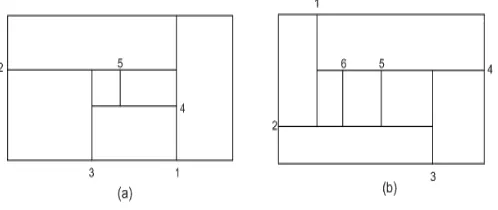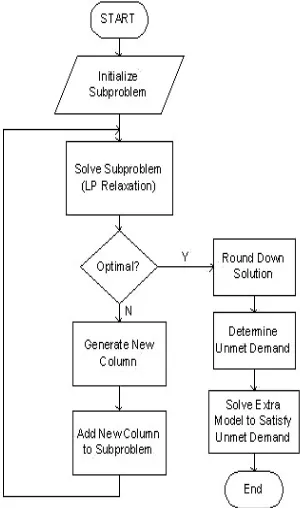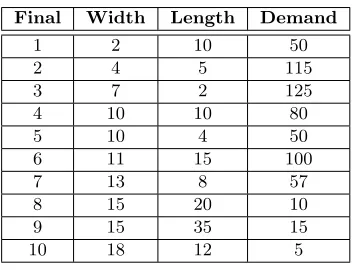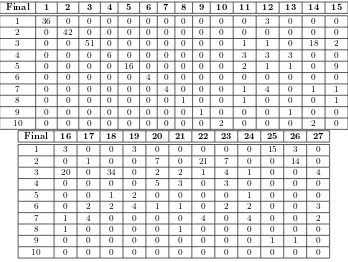COLUMN GENERATION TECHNIQUE
FOR SOLVING TWO-DIMENSIONAL
CUTTING STOCK PROBLEMS:
METHOD OF STRIPE APPROACH
K. Novianingsih, R. Hadianti and S. Uttunggadewa
Abstract.We consider two-dimensional cutting stock problems where single rectangular stocks have to be cut into some smaller rectangular so that the number of stocks needed to satisfy the demands is minimum. In this paper we focus our study to the problem where the stocks have to be cut with guillotine cutting type and fixed orientation of finals. We formulate the problem as an integer programming, where the relaxation problem is solved by column generation technique. New pattern generation is formulated based on method of stripe. In obtaining the integer solution, we round down the optimal solution of the relaxation problem and then we derive an extra mix integer programming for satisfying the unmet demands. The optimal solution of the original problem is the combination of the round-down solution and the optimal solution of the extra mix integer programming. A numerical example of the problem is given in the end of this paper.
1. INTRODUCTION
We consider two-dimensional cutting stock problem where stock sheets have to be cut into a set of smaller pieces finals so that the finals demand is satisfied. We need to determine a number of cutting patterns so that the number of stock sheets that is used minimum. The problem is a well known problem appears in many industries, such as flat glass industries, aircraft industries, ship builder, steel industries, and leather industries. The problem also appears in land development, facilities layout, and electrical circuit layout.
Received 7 November 2006, revised 9 January 2007, accepted 21 September 2007. 2000 Mathematics Subject Classification: Primary: 65C05. Secondary: 90C06, 90C10.
Key words and Phrases: cutting stock problem, integer programming, mix integer programming, column generation technique.
In practice, there are two cutting types: guillotine type and non-guillotine type. The guillotine cutting type is a cutting type where any cut must run from one edge of a stock sheet to the opposite edge in a straight line, which is illustrated by figure 1(a). Meanwhile in non-guillotine cutting type, a cut does not have to run from end to end of the stock sheet, which is illustrated in figure 1(b).
Figure 1: (a) A guillotine cutting pattern. (b) A non-guillotine cutting pattern.
We focus our study to the problem where we have single stock sheets, and both stock sheets and finals are of rectangular forms. The stock sheets have to be cut in guillotine cutting type and the orientation of finals is fixed. Fixed orientation of finals means that a final of length l and widthw can not be cut as a final of lengthwand widthl.
In solving the problem, we apply the column generation technique to the LP relaxation of the problem. The column generation technique for solving the two-dimensional cutting stock problem is actually has been studied in Alvarez-Valdes,
et.al[1]. In this paper we propose an alternative sub problem for generating a new column, which is based on the stripe method proposed by Hifi[8].
Alternative exact solution techniques for solving the two-dimensional cutting stock problem are proposed by Vanderbeck[9] and Hifi[8]. The technique in [9] is based on the combination of depth-first search using hill-climbing strategic and dynamic programming, meanwhile in [8] the combination of dynamic programming and hill-climbing technique is used to find the optimal solution. Some heuristic methods are proposed by Amaral & Wright[2] and Claire & Remila[4]. Our solution technique is simpler, and with help of AIMMS (see Bisschop[3]) the optimal solution of the relaxation problem can be obtained easily.
from the column generation, the round-down process, and the extra MIP.
We give an example of the problem and its optimal solution we obtain from the implementation of our complete algorithm. An open problem on the determi-nation of initial basis matrix is discussed in the end of this paper.
This paper is organized as follow. After introduction, in section 2 we derive a mathematical model of the problem and the column generation technique we use for solving the problem. In section 3 we discuss the sub problem for generating a new column, and in section 4 we discuss two algorithms for solving the unmet demands. A complete algorithm for solving the problem is given in section 5. A numerical example is given in section 6. We end this paper by giving a summary and open problem in section 7.
2. MATHEMATICAL MODEL AND THE COLUMN GENERATION TECHNIQUE
Suppose that the stock sheets are of lengthLand widthW,and suppose that there aremfinalsfiof sizeli×wiwith demanddi, i= 1,2,· · ·m.Letpbe acutting
pattern, and define aip as the number of final fi that will be obtained if a stock
sheet is cut with cutting pattern p.By definingxp as the number of stock sheets
that are cut with cutting pattern p, the two-dimensional cutting stock problem can be formulated as the linear programming
Minimize X
xp non-negative integer,∀p.
(1)
Since it is not easy to determine all possible cutting patterns, we can not directly apply a conventional solution method to the linear programming (1). We then apply the column generation technique to the relaxation of (1), and in the rest of paper we call the problem (1) as the master problem.
from the relation xB =B− 1
d, where dis the m-dimensional column vector with elementsdi.
To identify whether the current solution is optimal or not, we generate a new column y with elements yi, i = 1,2,· · ·, m, where the reduced cost associated to
the current basis matrixB,
1−
of our problem is given by
λ=1mB− 1
,
where1mis them-dimensional row vector with elements 1.If the minimum reduced cost is positive, then the current solutionxBis an optimal solution of the master problem. Otherwise, the new columnyenter the basis. This column generation is performed until we find an optimal solution for the master problem (1).
3. THE SUB PROBLEM FOR GENERATING A NEW COLUMN
The new column y that can improve the current basic feasible solution xB is generated by solving an integer problem, where its optimal solution gives us a feasible cutting pattern that gives the minimum reduced cost associated to the current solution xB. More precisely, the reduced cost 1−P
m
i=1λiyi becomes the
objective function and the constraints are constructed so that the new column y represents a feasible cutting pattern.
To construct a mathematical formulation for the feasible cutting pattern, inspired by the technique proposed in Hifi[8], we define a stripe, associated to the finalfi,of lengthLand widthwi that can be obtained by cutting the stock sheet
vertically. On this stripe we than can place some final fi and also some final fj
wherewfj <=wfi.In other word, as soon as we obtain a stripe, we deal with one dimensional cutting stock problem for placing the appropriate finals.
On a stock sheet we can obtain ⌊L
li⌋stripes of width ˜wi. Since we have m finals, we then haveK,the maximum number of possible stripes, which is given by
4. fori∈θk,define the variableyk
Since minimizing the reduced cost 1−Pmi=1λiyi is equivalent to maximizing
Pm
i=1λiyi,then the sub problem for generating a new cutting pattern then can be
written as
The first constraint of (2) ensures that the sum of widths of the selected stripes must be less than or equal to the width of the sheet. Meanwhile the second one ensures that for each selected stripe k, the total length of finals in stripek must be less than or equal to the length of the sheet. The integer programming (2) is a much smaller scale problem compare to (1), and can be solved by applying any solution technique for integer programming.
4. GETTING AN INTEGER SOLUTION
It should be noticed that the column generation we discuss in section is applied to the relaxation problem of (1). The optimal solution of the relaxation problem can be non integer, and we need to obtain an integer solution from this non-integer solution.
A simple and useful heuristic algorithm for satisfying the unmet demands is Largest In least Empty (LILE) algorithm. The algorithm is described in the following steps.
1. Round down the non-integer solution value, and determine the unmet de-mands.
2. Sort the finals in order of the unmet demands, from largest to smallest. 3. Place a final with the largest unmet demand in an empty stock sheet that
This algorithm is simple, but it should be noticed that this heuristic algorithm will not always give an optimal solution. In the following, we derive an extra Mix Integer Program (MIP) for solving the unmet demands.
Let F be the set of finals that its demand is not satisfied yet. The set F containsdf of finalf if the unmet demand of a finalf isdf.The number of extra
stock sheets for satisfying the unmet demands must be greater than or equal minextra=
with the same procedure as in section we can defineK,e the set of possible stripes. Denote a stripe byk, and letwk be the width. Fors∈S, k∈K,e andi∈θk define
s as the length of waste on sheets.
We generate stripes on the extra sheets so that the unmet demand can be satisfied while minimizing the waste on each extra sheet. This leads to the following mix integer programming, which we call the extra MIP.
Minimize X
The first and the second constraints of (3) are similar to ones in (2), but here we impose the variablesSL
s andSsW for measuring the wastes on the extra sheets.
The third constraint ensures that each element ofF will be placed exactly once on a stripe on an extra sheet. If the extra MIP (3) is not feasible, we then increase the value ofminextraby one and we update the setS so thatcard(S) =minextra.We
continue solving the problem (3) with the new value ofminextra until the problem
5. COMPLETE ALGORITHM FOR SOLVING TWO-DIMENSIONAL CUTTING STOCK PROBLEM
From the discussion in sections 2, 3 and 4, we have a complete algorithm for solving two-dimensional guillotine cutting stock problem, which is summarized in figure 2.
Figure 2: Algorithm for solving two-dimensional guillotine cutting stock problem
6. EXAMPLE
In this section, we give an example of the problem and its optimal solution that is obtained by applying the algorithm in figure 2. The initial basis matrix we use is diagonal matrix where the value of itsith diagonal element is the maximum number of finalfi that can be placed on a stock sheet. We use the extra MIP (3)
for solving the unmet demands, and the complete algorithm is then implemented in AIMMS 3.4.
Table 1: Stock sheets length of stock sheets 35
width of stock sheets 25
Table 2: Finals and its demands
Final Width Length Demand
1 2 10 50
2 4 5 115
3 7 2 125
4 10 10 80
5 10 4 50
6 11 15 100
7 13 8 57
8 15 20 10
9 15 35 15
10 18 12 5
The optimal solution of the relaxation problem of (1) is given in the table 4. The round-down solution is given in the most right column of 4. The unmet demands caused by the round-down process are given in table 5. To satisfy the unmet demands, we solve the extra MIP (3) in which in the first iteration we use
minextra =
» P
i∈Fliwi
LW
¼
= 5.
In other word, we guess that we need five extra sheets to satisfy the unmet demand. The extra MIP (3), indeed, is feasible with card(S) = 5, and the optimal extra cutting patterns are given as the last five columns in table 5.
Figure 3: The selected cutting patterns
Table 3: Cutting pattern matrix
Final 1 2 3 4 5 6 7 8 9 10 11 12 13 14 15
1 36 0 0 0 0 0 0 0 0 0 0 3 0 0 0
2 0 42 0 0 0 0 0 0 0 0 0 0 0 0 0
3 0 0 51 0 0 0 0 0 0 0 1 1 0 18 2
4 0 0 0 6 0 0 0 0 0 0 3 3 3 0 0
5 0 0 0 0 16 0 0 0 0 0 2 1 1 0 9
6 0 0 0 0 0 4 0 0 0 0 0 0 0 0 0
7 0 0 0 0 0 0 4 0 0 0 1 4 0 1 1
8 0 0 0 0 0 0 0 1 0 0 1 0 0 0 1
9 0 0 0 0 0 0 0 0 1 0 0 0 1 0 0
10 0 0 0 0 0 0 0 0 0 2 0 0 0 2 0
Final 16 17 18 19 20 21 22 23 24 25 26 27
1 3 0 0 3 0 0 0 0 0 15 3 0
2 0 1 0 0 7 0 21 7 0 0 14 0
3 20 0 34 0 2 2 1 4 1 0 0 4
4 0 0 0 0 5 3 0 3 0 0 0 0
5 0 0 1 2 0 0 0 0 1 0 0 0
6 0 2 2 4 1 1 0 2 2 0 0 3
7 1 4 0 0 0 0 4 0 4 0 0 2
8 1 0 0 0 0 1 0 0 0 0 0 0
9 0 0 0 0 0 0 0 0 0 1 1 0
10 0 0 0 0 0 0 0 0 0 0 0 0
Table 4: The optimal solution of the LP relaxation and the round-down solution
Selected cutting pattern Waste LP solution Round-down solution
13 10 11.3 11
14 87 2.5 2
18 29 0.67 0
19 75 12.97 12
21 82 10 10
22 25 1.22 1
23 49 5.36 5
24 75 12.09 12
26 10 3.7 3
27 116 0.63 0
Table 5: Unmet demands and the extra cutting patterns
Final Unmet demand 1∗ 2∗ 3∗ 4∗ 5∗
1 5 0 0 0 3 2
2 17 0 0 1 2 14
3 36 0 17 6 13 0
4 2 2 0 0 0 0
5 3 3 0 0 0 0
6 8 0 0 3 4 1
7 3 0 2 1 0 0
8 0 0 0 0 0 0
9 1 1 0 0 0 0
10 1 0 1 0 0 0
6. SUMMARY AND OPEN PROBLEM
In this paper we consider two-dimensional cutting stock problem with guillo-tine cutting type and fixed orientation. The column generation technique is applied for solving the LP relaxation of the problem, where the sub problem for generating a new column is constructed based on the method of stripe. The integer solution is obtained by round down the LP relaxation optimal solution, and we propose an extra MIP for solving the unmet demands.
The rate of convergence of the column generation technique depends on the initial basis matrix. In our example, for simplicity we use a diagonal matrix. From our experience, the diagonal basis matrix is not good initial basis matrix since, mostly, none of its columns was selected in the optimal solution. It is still an open problem to determine a better initial basis matrix, and further we can investigate the efficiency we get if we use the better initial basis matrix.
Acknowledgement. The authors thank Prof. J. J. Bisschop for introducing the column generation technique and for giving ideas on the extra MIP.
REFERENCES
1. R. Alvarez-Valdes, A. Parajon, and J.M. Tamarit, “A Computational study of LP-based heuristic algorithms for two-dimensional guillotine cutting stock problems”,
OR Spectrum24(2002), 179-192.
2. A. R. S. Amaral and M. Wright, “Efficient algorithm for the constrained two-dimensional cutting stock problem”,Int. Trans. Oper. Res. 8no. 1 (2001), 3-13. 3. J. J. Bisschop,AIMMS - Optimization modeling, Paragon Decision Tecnology B.V,
4. K. Claire and E. Re´mila, “A near-optimal solution to a two-dimensional cutting stock problem”,Math. Oper. Res. 25no. 4 (2000), 645-656.
5. V. Chv´atal,Linear programming, W.H. Freeman and Company, New York, 1983. 6. P. C. Gilmore and R. E. Gomory, “A linear programming approach to the
cutting-stock problem, part i”,Journal of Operation Research9(1961), 849-859.
7. P. C. Gilmore and R. E. Gomory, “A linear programming approach to the cutting-stock problem, part ii”,Journal of Operation Research9(1961), 863-888.
8. M. Hifi, “Dynamic programming and hill-climbing techniques for constrained two-dimensional cutting stock problems”,Journal of Combinatorial Optimization8(2004), 65-84.
9. F. Vanderbeck, “Computational Study of a Column Generation Algorithm for Bin Packing and Cutting Stock Problems”,Journal of Mathematical Programming86no. 33 (1999), 565-594.
K. Novianingsih: Department of Informatics Engineering Universitas Komputer Indone-sia, Bandung.
E-mail: [email protected].
R. Hadianti: Industrial and Financial Mathematics Research Group, Faculty of Mathe-matics and Natural Sciences, Institut Teknologi Bandung, Bandung 40132, Indonesia. E-mail: [email protected].





